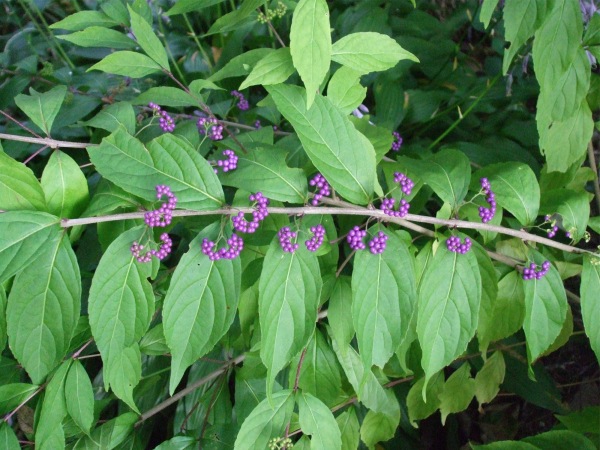
'Issai' beautyberry (Callicarpa dichotoma) (C) Jo Ellen Meyers Sharp
Some of the elements of fall color come in the shape of berries, which dot several plants in the late season landscape. Dogwood, holly, chokeberry and beautyberry are just a few of the plants adorned with showy fruit this time of year.
A lovely, but under used shrub is the beautyberry, which has clusters of amethyst or white berries along its branches through fall and into winter.
The American beautyberry (Callicarpa americana) gets 4 to 6 feet tall and wide and has a loose, open, growth habit with arching branches. The tiny, white or pinkish-white flowers in early to mid-summer are barely noticeable, but the berries that follow are quite showy. The white berry blooming shrub is Callicarpa americana lactea.
The native beautyberry’s natural range is from Maryland south to the West Indies and west to Arkansas and southern Mexico. It is rated hardy to USDA Zone 6, which is southern Indiana.
Although the American beautyberry’s survival may be marginal in cooler climates, there are two Asian species that do just fine in Zone 5, which includes central and northern Indiana.
The Japanese beautyberry (Callicarpa japonica) also is 4 to 6 feet tall and wide. It may have a slightly better form than the native, but the berries are not as plentiful. The cultivar ‘Leucocarpa’ has white berries.
Another Asian species with purple berries is (C. dichotoma). This one is in the 3 to 4 foot tall and wide range. The form is much less rangy and the fruiting much more prolific. Two popular cultivars are ‘Early Amethyst’ and ‘Issai.’ Of the two, ‘Issai’ seems the better one for central Indiana, reliably producing flowers and berries year after year. ‘Profusion’ (C. bodinieri) also is a wonderful plant, absolutely loaded with berries, but is in the 6-foot tall and wide range.
For beautyberry, hardiness relates more to the branches of the plant than the roots. Even the hardiest may have their branches killed by winter, but the roots will survive.
Fortunately, beautyberry blooms and sets fruit on current season’s growth, so winter damaged branches can be cut back to the base of the plant in early spring. New branches will sprout, leaf out, bloom and set fruit for another year of beauty.
The reason to wait before cutting them back is so you can enjoy the berries in the late season landscape. Also, birds and small mammals eat the berries. The branches also can be cut for indoor arrangements.
Beautyberries do best in part shade to full sun in well-drained soil. A mass plantings of three or more plants gives the best show, especially when sited with evergreens in the background.
Because of its size, ‘Issai’ works well in the perennial bed, where it can anchor a corner or take center stage as a specimen plant for a beautiful show in fall. Blue-blooming asters (Aster), the gold foliage of Arkansas blue star (Amsonia hubrichtii), the fall colors of oakleaf hydrangea (H. quercifolia) or peegee hydrangeas (H. paniculata), and ornamental grasses are good companion plants.
Beautyberry does best when watered during dry spells; however, it can tolerate slightly drought conditions once established. Fertilizer isn’t usually necessary.
 You Can Grow That! is the meme started by C.L. Fornari at Whole Life Gardening. However, this will probably be the last posting. For more info, please see C.L.’s blog.
You Can Grow That! is the meme started by C.L. Fornari at Whole Life Gardening. However, this will probably be the last posting. For more info, please see C.L.’s blog.